
Tufnell Park is an area in north London, England, in the London boroughs of Islington and Camden.

Islington is a district in the north of Greater London, England, and part of the London Borough of Islington. It is a mainly residential district of Inner London, extending from Islington's High Street to Highbury Fields, encompassing the area around the busy High Street, Upper Street, Essex Road, and Southgate Road to the east.

Liverpool Road is a street in Islington, North London. It covers a distance of 1+1⁄4 miles (2.0 km) between Islington High Street and Holloway Road, running roughly parallel to Upper Street through the area of Barnsbury. It contains several attractive terraces of Georgian houses and Victorian villas, many of which are listed buildings. There are a number of pubs, small businesses and restaurants along its route, as well as some secluded garden squares. The vast majority of the street is residential, with a bustling shopping and business area at the southern, Angel, end.

The London Borough of Islington is short of large parks and open spaces, given its status in recent decades as a desirable place of residence. In fact, Islington has the lowest ratio of open space to built-up areas of any London borough. The largest continuous open space in the borough, at 11.75 hectares, is Highbury Fields.

Lonsdale Square is a garden square in the Barnsbury district of Islington, North London. It is bounded by unusual Tudor Gothic Revival terraced houses, with picturesque gables and Elizabethan-style windows, and is probably unique among squares. All the houses are listed buildings. The central public garden contains flower beds and mature trees.

Caledonian Road in the London Borough of Islington, England, connects North London, from Camden Road near its junction with Holloway Road, and central London's Pentonville Road in the south. A a mile and a half long, it is known colloquially as the Cally and forms the entirety of the A5203.
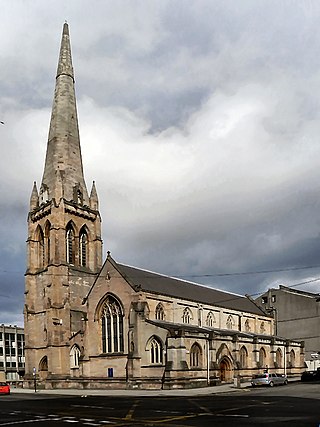
John Thomas Emmett was an English architect and designer based in London.
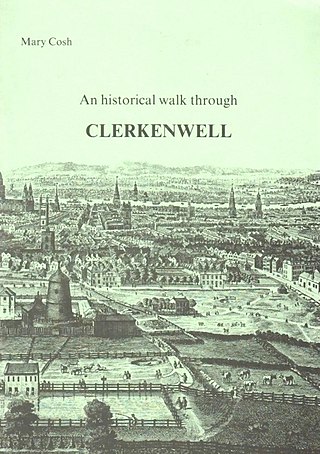
Ethel Eleanor Mary Cosh, FSA was a British freelance journalist and local historian who was known for her works on the history of Islington, London. Her book, A History of Islington (2005), was the first full-length history of the area since the mid-nineteenth century. She also wrote two historical works relating to Scotland. Cosh died in December 2019 at the age of 100.
Joseph Kay (1775–1847) was an English architect, particularly active in the early years of the 19th century, and associated with the layout of central Greenwich and with Hastings. He was one of the original members of the Royal Institute of British Architects, and was elected a fellow in 1834.

Canonbury Square is a garden square in Canonbury, North London. It is bounded by terraces of mostly Georgian houses, many of which are listed buildings. The central public gardens contain attractive flower beds and several London plane trees of great age. The Evening Standard newspaper described it in 1956 as “London’s most beautiful square”. Many significant figures from the arts and literary worlds have lived in the square, including George Orwell, Evelyn Waugh, Samuel Phelps, Duncan Grant and Vanessa Bell.

Canonbury House is the name given to several buildings in the Canonbury area of Islington, North London which once formed the manor house of Canonbury, erected for the Canons of St Bartholomew's Priory between 1509 and 1532. The remains today consist of Canonbury Tower and several buildings from the 1790s, some of which incorporate parts of the late 16th-century manor house. Today, the Tower and the other buildings, including a 1790s building today also named "Canonbury House", are arranged around the road named Canonbury Place.
The Metropolitan Public Gardens Association is a charity in London for the purposes of the preservation of public parks and gardens, established in 1882. It facilitated the creation of new public open spaces, including from philanthropic landowners within its membership. The MPGA was involved in the formation and development of other amenity organisations. The charity still exists; in recent decades its emphasis has changed to smaller parcels of land and smaller projects within larger spaces, as well as to themed projects. The MPGA was the starting point for the careers of the ground-breaking female landscape gardeners Fanny Wilkinson and Madeline Agar.
John Spencer Square is a neo-Georgian residential garden square in the heart of the Canonbury conservation area in Islington, London.

Barnsbury Square is a garden square in the Barnsbury district of Islington, North London. It is bounded by Victorian villas and Regency and Victorian terraces, several of which are listed buildings. The central public gardens contain flower beds and mature trees.
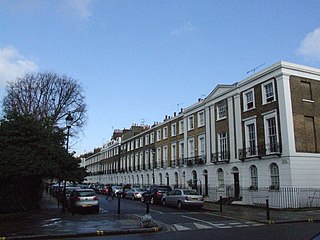
Gibson Square is a garden square in the Barnsbury district of Islington, North London. It is bounded by Regency and Victorian terraced houses, most of which are listed buildings. The central public gardens contain flower beds and mature trees, and an unusual building resembling a classical temple.

Milner Square is a garden square in the Barnsbury district of Islington, North London. It is bounded by early Victorian terraced houses, which are all listed buildings. Historic England describes it as "important for the radical logic of its design, of a type rarely seen outside Scotland and the North, and unlike anything in London."
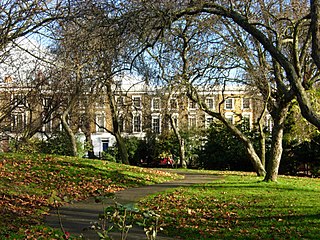
Thornhill Square together with the adjacent Thornhill Crescent form a garden square in the Barnsbury district of Islington, North London. It is bounded by Victorian terraced houses, all of which are listed buildings. The central public gardens contain flower beds, mature trees, and a children's play area, and the Crescent gardens surround the Victorian Church of St Andrew.
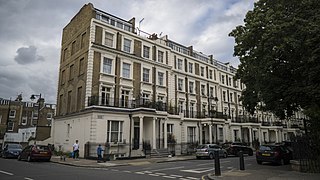
Arundel Square is a garden square in Barnsbury, North London. It is bounded on three sides by terraces of Victorian houses, and on the fourth with modern flats. The central public gardens contain mature trees, attractive flower beds and playground equipment.

Wilmington Square is a garden square in Clerkenwell, Central London. It is bounded by Regency and Victorian terraces, most of which are listed buildings. The central public gardens contain flower beds and mature trees, a pavilion or shelter, and a water fountain.




















